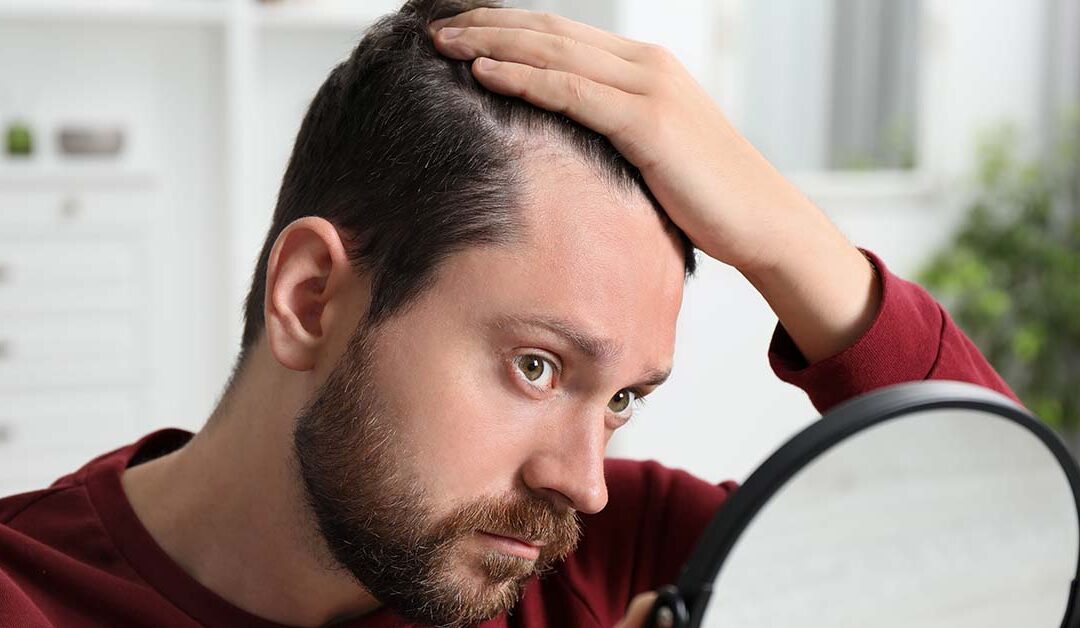At its most basic, anagen effluvium is hair loss during the growth stage of your hair lifespan. The anagen phase is the time during which hair is actively growing. Our hair goes through several different phases, from growing to resting to shedding. Shedding – something most people think of as hair loss – is a natural part of that cycle.
But when the hair growth cycle is interrupted, that hair loss becomes a problem. Anagen effluvium is one of those times. Effluvium, in terms of hair loss, means “outflow.”
What Causes Anagen Effluvium?
There are two primary causes for anagen effluvium: toxicity caused by medication, medical treatment, or poisons; and a genetic problem called loose anagen hair syndrome.
This study from the National Institutes of Health explains it this way: “Anagen effluvium is a form of non-scarring alopecia, with two distinct types of anagen effluvium: dystrophic anagen effluvium and loose anagen syndrome. Dystrophic anagen effluvium is most commonly associated with chemotherapy; however, it can also manifest in cases of protein-energy deficiency, pemphigus, alopecia areata, and different forms of heavy metal poisoning.”
In short, anagen effluvium is the hair loss that most people suffer when they have chemotherapy or radiation therapy for treatment of another disease, usually cancer. Some treatments for autoimmune conditions can also cause anagen effluvium.
What Does Anagen Effluvium Look Like?
For children, those most likely to develop loose anagen syndrome, the hair loss usually appears more as breakage than hair falling out. Hair becomes brittle and breaks leaving behind short spots with no rhyme or reason.
The much more common form of anagen effluvium is in patients who are being treated with harsh medications for an underlying condition or who have been subjected to heavy metal poisoning somehow. For these patients, hair loss begins within days of the medical treatment beginning and is characterized by rapid hair loss over much of the scalp.
Medscape describes it this way, “Anagen effluvium is a non-scarring alopecia that leaves the follicular ostia intact. Most hair follicles are in the anagen stage at any given time; consequently, anagen alopecia affects a large percentage of the scalp.” Since often more than 70% of the hair on our scalps is in the anagen phase, anagen effluvium affects most of the scalp at the same time.
Because it is usually caused by a reaction to medication that is in the bloodstream, anagen effluvium often presents differently from other forms of hair loss by impacting body hair, eyebrows, eyelashes, and even hair in the armpits and groin.
Does Hair Grow Back After Anagen Effluvium?
The good news about anagen effluvium is that in most cases it is reversible. In some cases, it can be prevented or the severity reduced.
According to Science Direct, minoxidil and other hair growth medications can be effective at restarting hair growth once the treatment causing the hair loss stops. Short version: After you are done with chemotherapy, your hair usually grows back, and some medications can speed up the process.
While no studies have shown that minoxidil will prevent hair loss due to drug-induced alopecia, there is some limited research that suggests scalp cooling may prevent some of the hair loss. Scalp cooling is exactly what it sounds like. During your medical treatment – such as the chemotherapy infusion – various treatments are used to cool down the scalp, restricting the blood flow to your hair follicles. These interventions can sometimes limit hair loss due to chemotherapy. European cancer treatment centers are increasingly offering cooling caps during chemotherapy treatment.
LA FUE Hair NY Helps You Deal With Anagen Effluvium
If you are preparing for drug-therapy that may cause hair loss or have already experienced hair loss due to drug-induced alopecia, LA FUE Hair New York wants you to know that you are not alone. We understand that hair loss makes this devastating medical treatment even harder to handle and we can help you find your way back to healthy hair. Schedule today to start your recovery.


